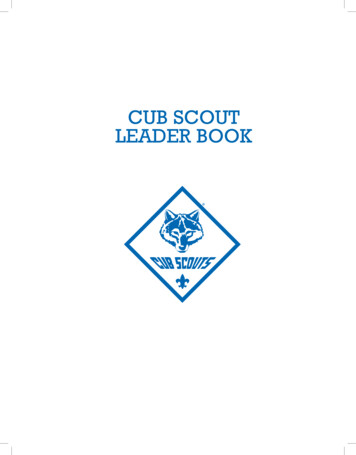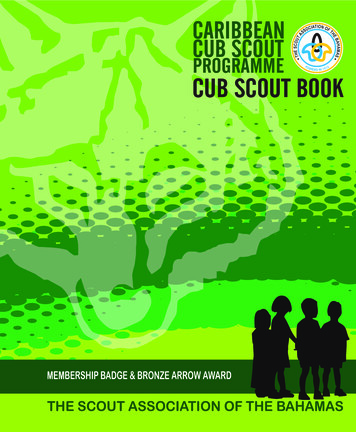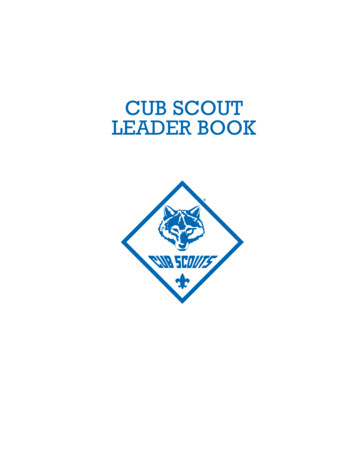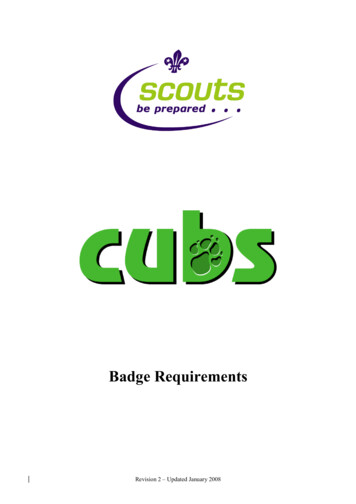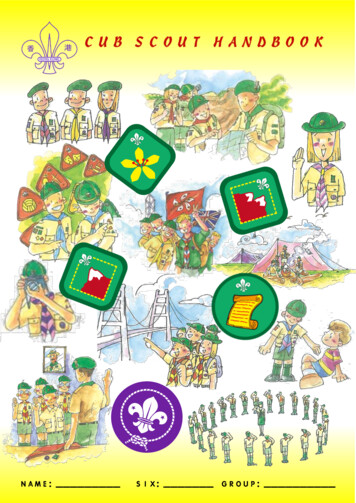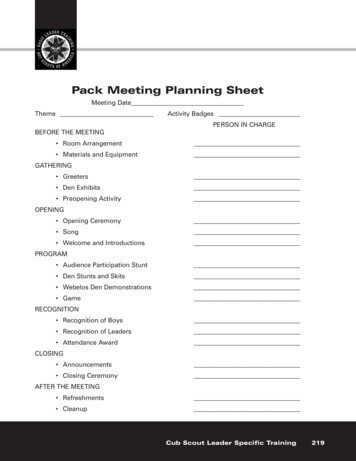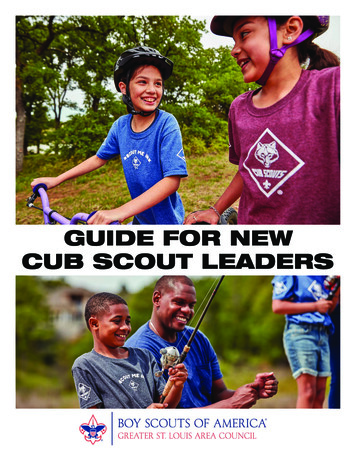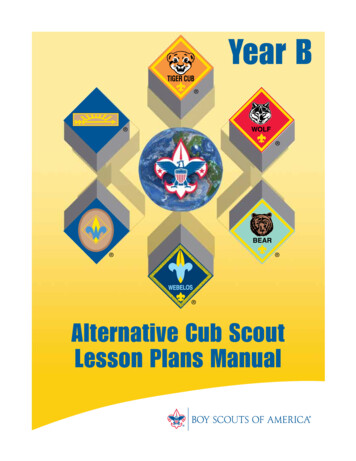
Transcription
Year B Alternative Cub ScoutLesson Plans Manual
ContentsYear B Explanation.3Meeting 20: Do the Right Thing!.139Advancement.3Meeting 21: Snack Time.143Reminders.3Meeting 22: Physical Fitness and Basketball Belt Loops.147Welcome to Cub Scouting.4Meeting 23: Be Prepared!.149What Is This Cub Scouting Thing?.5Meeting 24: Makeup Meeting.157What Is Cub Scouting?.5Meeting 25: Let’s Go Outdoors.159Understanding Cub Scout–Age Boys.15Meeting 26: Marbles Belt Loop.165Cub Scouts With Disabilities.18Meeting 27: Soccer Belt Loop.171Uniforms and Insignia.22Meeting 28: Kickball Belt Loop.174Leader and Family Roles and Responsibilities.31Meeting 29: Duty to God.177Leaders.31Meeting 30: Webelos-to-Scout Transition.180Parents and Families.48Meeting 31: Awards Banquet.186Materials Needed for Each Syllabus Week.59Progress Toward Rank Awards.188Advancement Help.62Organization, Roles, Ranks, and Advancement.191Belt Loops—All Cub Scout Ranks.64How Cub Scouting Is Organized.191Advancement Request for Awards Ceremony 1.65Advancement Request for Awards Ceremony 2.66 The Tiger Cub, Cub Scouting, andWebelos Scouting Programs.199Webelos Arrow of Light Check-off Sheet.67Webelos-to-Scout Transition.200Advancement Report.69Advancement and Awards.204Meeting 1: Welcome to Cub Scouts.70Keeping Cub Scouts Together and Growing.211Meeting 2: Feats of Skill.73Membership.211Meeting 3: What Makes America Special.76Cub Scout Pack School Night/Roundup Agenda.213Meeting 4: Family and Community.82Insurance and Unit Assets.215Meeting 5: Sports, Sports, Sports.86Charter Renewal.216Meeting 6: Friends and Collections.91Financing the Pack.221Meeting 7: Leave No Trace.94Oh, the Things You Can Do in Scouting!.227Meeting 8: Song and Fun Time.98Managing Boys.227Meeting 9: Preparing for the Party.100Pack Activities.230Meeting 10: Recognition Party.102Health, Safety, and First Aid.239Meeting 11: More Leave No Trace.106Outdoor Activities.253Meeting 12: Reading Is Fun.109Cub Scout Camping.260Meeting 13: Building Things.115The Cub Scout Academics and Sports Program.270Meeting 14: Preparing for the Pinewood Derby.118Unit Leadership Enhancements.271Meeting 15: Putting the Finishing Toucheson the Pinewood Derby Car.121More Activities and Songs.276Meeting 16: Pinewood Derby.124Add Sparkle to Your Meetings.276Meeting 17: Game Playing and Healthy Eating.127Set the Tone With a Song.283Meeting 18: Communication/Fitness.132Resources, Forms, and Applications.300Meeting 19: What’s Cooking?.135Glossary.3371
Year B ExplanationThis syllabus is designed for packs that have all the leaders to break into dens for each rank or for leaders whodo not have the adult assistance to break a pack up into dens for each rank. This syllabus is also designed for unitsthat do not have enough boys per den. Although there are not requirements for each rank every week, the program isset up so the Bobcat, Tiger, Wolf, Bear, Webelos, and Arrow of Light awards can be earned over a 31-week period forboys in coinciding rank/grade levels.Year B is designed to fit in with the school year schedule, which is what most Cub Scout packs follow. Due today camp and the closing of many chartered organizations, we do not hold Cub Scout meetings in June or July.AdvancementThe boxes at the end of each syllabus week list the actual requirements from the Cub Scout handbooks that arecompleted during that particular week.Advancement is tracked by attendance, so it is very important to keep track of boys each week. Using a sign-insheet for each meeting will help with this. You should also use an attendance summary sheet so after each meetingleaders can record attendance on a sheet that shows all 31 weeks of program and all of their boys. Use the“Advancement Help” section in this book to determine which advancement awards each rank of Cub Scouts shouldget at each awards ceremony.All rank badge requests should be submitted online at .aspx or onan Advancement Report, No. 34403, provided on page 69. Throughout the school year, you will only need Bobcat badgesfor Cub Scouts who are new to the program. Other badges such as Tiger, Wolf, Bear, Webelos, and Arrow of Light will beearned until the end of the school year after all syllabus weeks have been completed. The Arrow of Light is an individualaward that Webelos II Scouts can earn. The requirements for earning this award can found on page 67. It is theresponsibility of the Cubmaster, den leader, or parent to make sure each requirement has been met.Items such as progress beads, belt loops, and Webelos pins do not need to be turned in on an AdvancementReport. For convenience, we have included two (one for each awards ceremony) Advancement Request forms forthese items.You can also give out Progress Toward Rank/Immediate Recognition kits, usually in the first meeting. Trackingbeads can be a little confusing since Tiger Cubs earn one bead for every achievement they complete, and Wolf andBear Cub Scouts earn one bead for every three achievements completed. To make this easier, you can find charts tohelp you figure out which beads to give out for each awards ceremony in the “Advancement Help” section of thisbook (pages 62 and 63). The other awards we supply are certificates for perfect attendance, consistently wearinguniforms, Good Turns, and popcorn sales.RemindersAt the end of each syllabus week, there is a list of reminders and coming events.Many Cub Scout resources are available online. Go to Scouting.org/CubScouts/Leadersor scan this QR code with your smartphone.Download a free QR reader for your smartphone at scan.mobi.3
Welcome to Cub ScoutingWelcome to Cub Scouting! Since 1930, Cub Scouting has offered fun with a purpose to millions of Americanboys. Thanks to volunteers like you, these boys have developed values, learned skills, made friends, strengthenedfamily relationships—and had a great time in the process.This book is designed to help you make the most of your time as a Scouting volunteer. Whether you are a denleader, a Cubmaster, a committee member, or a program manager, or you take on some other leadership role, you’llfind the resources here to make your Cub Scouting experience the best it can be.Our goal is to help you get started quickly; that means quick introductions to some important topics and deepercontent where appropriate. Where more detailed information is necessary, we’ll refer you to other Boy Scouts ofAmerica publications, including content you can find at www.scouting.org, the BSA’s website. We also encourage youto seek help from experienced leaders in your pack, as well as commissioners—volunteers in your Scouting districtwhose sole purpose is to support people like you.4
What Is This Cub Scouting Thing?What are Cub Scouting’s foundational aims, beliefs, and values?How do we go about achieving these aims?What about boys?All this and more . . .What Is Cub Scouting?Cub Scouting is a program of the Boy Scouts of America, whose overall mission is to help young people buildcharacter, learn citizenship, and develop personal fitness. While the BSA serves boys from ages 6 through 20 andgirls from ages 14 (or 13 with completion of eighth grade) through 20, Cub Scouting focuses on boys in the firstthrough fifth grades (or from ages 7 through 10).Cub Scouting Is for All Boys. Cub Scouting is for boys of all sizes, shapes, colors, and backgrounds. Someare gifted students or talented athletes; others struggle in these areas. Some have strong, stable families; others facesocial and economic challenges. Some live in cities, some live in suburban areas, and some live in rural communities.Some have physical, mental, or emotional disabilities that make ordinary activities difficult. Because of its flexibilityand its emphasis on doing one’s best, Cub Scouting easily adapts to all these situations.Cub Scouting Is for Families. The family is the most important influence on boys’ development. Cub Scoutingseeks to support the family—whatever it looks like—and to involve families in Scouting activities. Cub Scouting issensitive to the needs of today’s families, and it provides opportunities for family members to work and play together,to have fun together, and to get to know each other better.Cub Scouting Is Fun. Boys join Cub Scouting because they want to have fun, but they instinctively understandthat fun means more than just having a good time. It also means getting satisfaction from meeting challenges, havingfriends, and feeling they are important to other people. When Cub Scouts are having fun, they are also learning newthings, discovering and mastering new skills, gaining self-confidence, and developing strong friendships.Cub Scouting Has Ideals. In an age when values sometimes seem passé, Cub Scouting maintains its ideals ofcharacter development, citizenship training, and personal fitness. The Cub Scout Promise is a pledge of duty to God andother people. The Law of the Pack is a simple formula for good citizenship. The Cub Scout motto is a code of excellence.Cub Scouting Provides Adventure. Cub Scouting helps fulfill a boy’s desire for adventure and allows him touse his vivid imagination while taking part in skits, games, field trips, service projects, and more. Boys find adventurein exploring the outdoors, learning about nature, and gaining a greater appreciation for our beautiful world.5
Cub Scouting Helps Boys Develop Skills and Interests. Cub Scouts learn many useful and varied skills.They develop ability and dexterity, and they learn to use tools and to follow instructions. Badges and awardsencourage them to learn about a variety of subjects, including conservation, safety, physical fitness, communityawareness, sports, and religious activities. The skills they learn and interests they develop could lead them to careersor lifelong hobbies.Cub Scouting Has an Advancement Plan. The Cub Scout advancement plan recognizes boys’ individualefforts and achievements, teaches them to do their best, and strengthens family ties as leaders and family memberswork with them on requirements. Boys enjoy receiving badges for their achievements, but the real benefit comes fromthe skills, knowledge, and self-esteem they develop along the way.Cub Scouts Belong. Belonging is important to boys; they like to be accepted as part of a group. In Cub Scouting,boys take part in interesting and meaningful activities with their friends, learning sportsmanship, citizenship, and loyalty.The Cub Scout uniform, symbols like the Cub Scout sign, and being a member of a den help boys feel part of a distinctgroup that shares a common purpose.Cub Scouting Teaches Boys to Reach Out. Cub Scouting provides opportunities for boys to reach out into thewider community while maintaining a link with secure foundations at home, school, and religious organizations.Through field trips, boys get to know their community better. Through service projects and other community activities,they learn what it means to be a good citizen.Cub Scouting Teaches Duty to God and Country. Through interfaith activities and the religious emblemsprogram, Cub Scouting helps boys fulfill their duty to God. Through flag ceremonies, service projects, and otheractivities, Cub Scouting helps boys become useful and participating citizens.Cub Scouting Provides a Year-Round Program. When school ends, Cub Scouting continues. Boys have morefree time during the summer, so summer is a great time for Cub Scouting. Den and pack activities take on a moreinformal feel and are often held outdoors. Day camp and resident camp programs run by Scouting districts and councilsare often the highlight of the Cub Scout year, offering activities that local packs couldn’t easily provide.Cub Scouting Helps Organizations. A Cub Scout pack is chartered to an organization in your community—a school-based parents’ organization, a religious organization, or a service club or organization. Cub Scoutingis a resource that organization uses to further its outreach and achieve its goals for serving young people.Purposes of Cub ScoutingThe Cub Scouting program has 10 purposes related to the overall mission of the Boy Scouts of America—to build character, learn citizenship, and develop personal fitness: Character Development Spiritual Growth Good Citizenship Sportsmanship and Fitness Family Understanding Respectful Relationships Personal Achievement Friendly Service Fun and Adventure Preparation for Boy ScoutsEvery Cub Scouting activity should help fulfill one of these purposes. When considering a new activity, ask whichpurpose or purposes it supports. Not everything in Cub Scouting has to be serious—far from it! Silly songs, energeticgames, and yummy snacks all have their place in the program.6
Cub Scout IdealsThe Cub Scout ideals are practices that bring the program’s values to life. They are principles boys learn andincorporate into their everyday lives. Take every opportunity to point out how an activity or service project your CubScouts are doing connects with the Cub Scout ideals: The Cub Scout Promise The Law of the Pack The Cub Scout mottoHelp them see that living the ideals of Cub Scouting is a good way to live.The Cub Scout PromiseI, (name), promise to do my bestto do my duty to God and my country,to help other people, andto obey the Law of the Pack.The Cub Scout PromiseThis simple promise encompasses most of what a Cub Scout (and a Cub Scout leader, for that matter) shoulddo. It helps Cub Scouts develop a sense of spiritual awareness, loyalty, unselfishness, self-discipline, and service toothers. With some changes in wording, it will follow Cub Scouts into Boy Scouting.Cub Scout–age boys are eager to learn and are open to new ideas. You have the priceless opportunity to helpboys learn to live the Cub Scout Promise. The way to do that is by explaining the words in simple language that boyscan understand.“I promise . . .” Making—and keeping—a promise is a very grown-up thing to do. When a boy makes the CubScout sign and says, “I promise,” he’s taking an important step on the road to adulthood.“To do my best . . .” Our society often emphasizes being the best; Cub Scouting emphasizes doing your best.That’s an important distinction. Everybody is good at different things, so one person’s best is not the same assomeone else’s. The Cub Scouting program encourages boys to give their best possible effort rather than just try todo better than someone else. When boys try their hardest, they feel good about themselves and often find they cando even better than they thought they could.“To do my duty to God . . .” The BSA maintains that no member can grow into the best kind of citizen withoutrecognizing an obligation to God, although it is absolutely nonsectarian in its attitude toward religious training. CubScouts are encouraged to thank God for their blessings, to be faithful in their religious duties, and to respect otherpeople’s religious beliefs even when those beliefs differ from their own.“And my country . . .” Cub Scouts are too young to vote, to serve in the military, or to worry about obeying mostlaws. However, they can live their duty to country by showing respect for the U.S. flag, by standing at attention when thenational anthem is played, by caring for people in their community, and by using our country’s resources wisely.7
Akela Who?Many Cub Scouttraditions come fromRudyard Kipling’sThe Jungle Book. See“The Story of Akela andMowgli” in the Wolf CubScout Handbook.“To help other people . . .” For a Cub Scout, helping people can include all sorts of things: taking out thegarbage, making his bed without grumbling, being friends with new kids at school, raking leaves for elderly neighbors,and collecting food for people who don’t have enough to eat. It means thinking about other people before ourselvesand treating other people like we would want them to treat us.“And to obey the Law of the Pack.” The Law of the Pack guides the Cub Scout’s actions in Cub Scouting and inhis everyday life. It helps develop a law-abiding attitude that can carry over to home, school, and other settings.The Law of the PackThe Cub Scout follows Akela.The Cub Scout helps the pack go.The pack helps the Cub Scout grow.The Cub Scout gives goodwill.The Law of the PackYoung boys have lots of rules to follow at home and at school, but Cub Scouts need to follow only the four rulesfound in the Law of the Pack.“The Cub Scout follows Akela.” In Cub Scouting, Akela (pronounced ah-KAY-la) means “good leader.” To aCub Scout, Akela is a parent, teacher, religious leader, or Cub Scout leader. Akela is anyone who has shown abilityand willingness to be a good leader for Cub Scouts to follow. The key word in this phrase of the Law of the Pack isfollows. When following, a Cub Scout should choose a good leader to emulate. By being a good follower, he takesthe first steps toward being a good leader.“The Cub Scout helps the pack go.” Cub Scouts help the pack go by being loyal members, attending asmany meetings as possible, following the leaders, and making the pack better through their active participation. Thekey word in this phrase is helps. It means doing one’s share. By helping the pack, Cub Scouts have more fun andfeel satisfied.“The pack helps the Cub Scout grow.” Cub Scouting helps boys grow into better people. They learn how todo new things and to reach out to others. The key word in this phrase is grow.“The Cub Scout gives goodwill.” It’s a good feeling for a boy to do what he is expected to do. It’s an evenbetter feeling when he does more than expected. Help boys look for ways to make other people happy. Anything thatmakes life a little easier or more pleasant for someone else is goodwill. The key word in this phrase is gives.The Cub Scout MottoDo Your Best.The Cub Scout MottoDoing your best is one of the most important things Cub Scouts learn. When boys compare themselves to otherpeople, they can become complacent (if they’re high achievers) or discouraged (if they have to work harder toaccomplish the same goals). Focusing on doing their personal best helps them feel good about themselves and seetheir potential for doing even better. Help boys see that no one can find fault with them if they always do their best.8
The Methods of Cub ScoutingTo accomplish its purposes and achieve the overall goals of building character, learning citizenship, anddeveloping personal fitness, Cub Scouting uses seven methods: Living the Ideals Belonging to a Den Using Advancement Involving Family and Home Participating in Activities Serving Home and Neighborhood Wearing the UniformThe methods bring Cub Scouting to life for boys and their families.Living the Ideals. Cub Scouting’s values are embedded in the Cub Scout Promise, the Law of the Pack, theCub Scout motto, and the Cub Scout sign, handshake, and salute. These practices help establish and reinforce theprogram’s values in boys and the leaders who guide them.Belonging to a Den. The den—a group of six to eight boys who are about the same age—is the place whereCub Scouting starts. In the den, Cub Scouts develop new skills and interests, they practice sportsmanship and goodcitizenship, and they learn to do their best, not just for themselves but for the den as well. For these lesson plans,dens may be combined if there are not enough den leaders. For these lesson plans, dens may be combined if thereare not enough den leaders.Using Advancement. Recognition is important to boys. The advancement plan provides fun for the boys, givesthem a sense of personal achievement as they earn badges, and strengthens family understanding as adult familymembers and their den leader work with boys on advancement projects.Involving Family and Home. Whether a Cub Scout lives with two parents or one, a foster family, or otherrelatives, his family is an important part of Cub Scouting. Parents and adult family members provide leadership andsupport for Cub Scouting and help ensure that boys have a good experience in the program.Participating in Activities. Cub Scouts participate in a huge array of activities, including games, projects,skits, stunts, songs, outdoor activities, trips, and service projects. Besides being fun, these activities offeropportunities for growth, achievement, and family involvement.Serving Home and Neighborhood. Cub Scouting focuses on the home and neighborhood. It helps boysstrengthen connections to their local communities, which in turn support the boys’ growth and development.Wearing the Uniform. Cub Scout uniforms serve a dual purpose, demonstrating membership in the group(everyone is dressed alike) and individual achievement (boys wear the badges they’ve earned). Wearing the uniform tomeetings and activities also encourages a neat appearance, a sense of belonging, and good behavior.Defining CharacterCharacter is a collection of core values a person possesses that lead to principled, moral commitment andaction. It defines why we do what we do when we’re faced with a moral or ethical decision.People have long debated how to develop character. Some say it is done by telling kids what is right and good.Others say kids develop character by practicing what is right and good. Still others say kids develop character bylearning to reason about what is right and good.9Blue and GoldBlue and gold are thecolors of Cub Scouting,and they have specialmeaning. Blue standsfor truth and spirituality,steadfast loyalty,and the sky above.Gold stands for goodcheer, happiness,and warm sunlight.
The Scouting program takes all three aspects of character development into account. Consider the value ofcompassion. Cub Scouting tells boys that compassion is important by teaching them the Cub Scout Promise, whichincludes the phrase “to help other people.” They practice compassion when they participate in a service project. And theyreason about compassion when asked to reflect on the service they’ve done or to think about a thorny ethical dilemma.Principles of Character DevelopmentThree principles underlie character development: a set of core values; an understanding that character includesthought, commitment, and practice; and an emphasis on character in all aspects of life.Character Has a Set of Core ValuesCub Scouting promotes 12 Core Values in helping boys develop aithHealth and fitnessHonestyPerseverancePositive attitudeResourcefulnessRespectResponsibilityThese values are at the core of what it means to be involved in Scouting. If Cub Scouts are to be honest,responsible, courageous, and all the rest, leaders must be as diligent and skilled about teaching these values as theyare about teaching the other aspects of the program. The 12 Core Values must be an active part of the Cub Scoutinglanguage and culture.Character Includes Knowledge, Commitment, and PracticeIt’s not enough to memorize words and slogans. Cub Scouts must learn to reason when evaluating competingvalues. They must be committed and have the skills necessary to act on their convictions despite peer and worldlypressures. Not every Scouting activity will be designed to develop each of these three areas, but those that have thegreatest effect on character involve thought, commitment, and practice.For example, a service project is just an activity until Cub Scouts reflect on the experience, how it made themfeel, or how to fix the underlying problem.Character Should Be Promoted in All Phases of LifeJust as it isn’t enough to develop any one area of character to the exclusion of another, it isn’t enough to focuson character development in only one area of a Cub Scout’s life. Character development must be promotedthroughout all phases of life, whether in the den, at home, at school, at a place of worship, or in the community.Character development should not be viewed as something done occasionally as part of a separate program oras part of only one area of life. It should be a part of everything a Scout does.With a little thought, leaders can draw character lessons from every aspect of the Scouting experience. Serviceprojects, ceremonies, games, skits, songs, crafts, and other den and pack activities can all promote the 12 CoreValues. Take advantage of opportunities to emphasize to boys that character is important to the individual, to thefamily, to the community, to our country, to the world, and ultimately to God.Since character development should happen in all areas of life, Scouting seeks to work in concert with the familyand other institutions. We honor the home, religious institutions, schools, and communities as critical influences onthe character development of youth.10
Defining the 12 Core ValuesWhile most of Cub Scouting’s 12 Core Values are self-explanatory, it’s important to start with common definitionsand some examples of practical application. No one value is more important than another; they’re presented here inalphabetical order.1.2.3.Citizenship: Contributing service and showing responsibility to local, state, and national communities. Know the names of the president and vice president of the United States. Know the names of your state governor and heads of local government. Respect the flag of the United States. Know and understand the Pledge of Allegiance. Know and understand our national anthem, “The Star-Spangled Banner.” Be a good neighbor. Obey laws and rules, and respect people in authority. Protect the environment and our natural resources. Be helpful. Do a Good Turn for your family, school, or community.Compassion: Being kind and considerate, and showing concern for the well-being of others. Be friendly. Smile. Be interested in and sensitive to the feelings of others. Show kindness. Be kind to those less fortunate than yourself. Help those in need. Consider the feelings and needs of others when playing, talking, or working together. Help someone who is being treated unfairly. Look for ways to include others in the group. Be willing to forgive others.Cooperation: Being helpful and working together with others toward a common goal. Be helpful to others, and work together. Do your part in a project. Listen to and consider the ideas of others. Be unselfish. Be cheerful. Share things with others. Be happy for the good fortune of others on the team. Use everyone’s special talents. Be friendly. Be willing to share the credit.11
4.5.6.7.Courage: Being brave and doing what is right regardless of our fears, the difficulties, or the consequences. Tell the truth despite the consequences. Admit mistakes when you make them. Apologize for mistakes and wrongdoing. Accept the consequences of your actions. Stand up for people who are less fortunate than you. Stand up for the beliefs of your faith or religion. Resist peer pressure to do the wrong thing. Stand up for your beliefs about what is right and wrong.Faith: Having inner strength or confidence based on our trust in God. Define your duty to God as it is taught in your family. Understand and practice your religious tradition. Be cheerful about your religious duties. Remain confident in difficult situations. Show reverence for churches, holy places, and religious
character development, citizenship training, and personal fitness. The Cub Scout Promise is a pledge of duty to God and other people. The Law of the Pack is a simple formula for good citizenship. The Cub Scout motto is a code of excellence. Cub Scouting Provides Adventure. Cub Scouting hel
